Ecommerce marketing is at the heart of digital success.
Every online business owner wants to increase traffic to their e-commerce store. The more traffic you have, the more opportunities there are for sales. To gain valuable traffic, however, you need the right promotional strategies.
Now that tools like Shopify exist to make designing and running your online store easy, anyone can start selling products online in no time. However, simply making a store won’t guarantee success.
You’ll want to start with e-commerce marketing. Simply put, that’s any marketing you do to drive traffic and sales to your online store. This includes things like ads, organic social media posts, email campaigns, or even promotions on your own website. The goal of e-commerce marketing is to move a person from the potential customer stage through to making a purchase and then to retain them as a consistent, happy customer.
In this article, we’re going to cover a selection of Ecommerce marketing tactics you’ll wish you knew when you launched your Shopify store.
Website marketing
1. Pay attention to abandoned carts
Cart abandonment is a common issue for e-commerce store owners. According to Statista, the average rate for cart abandonment in e-commerce is around 79.17%. That means there’s almost an 8 in 10 chance that someone who places an item in their basket within your website won’t actually buy it.
The good news? Cart abandonment strategies give you a second chance to convert that client. Focusing on cart abandonment campaigns means that you reach out to customers that are already aware of your product or service, to convince them to finish their transaction.
There are plenty of ways to run a cart abandonment strategy. One of the most common is to send an automated email, reminding customers of what they’re missing out on.
Take a look at this simple solution from Primally Pure, for instance. The email encourages buyers to come back and complete their purchase with the reminder that the products in their cart are popular and selling quickly.
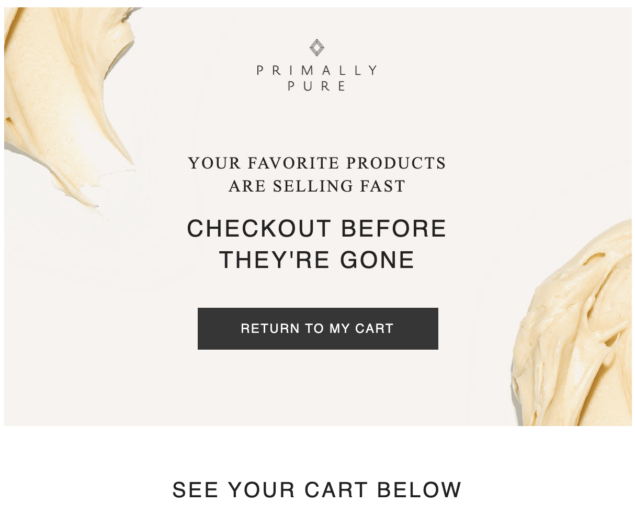
2. Try upselling
If you’ve already successfully attracted someone to your website and convinced them to add a product to their cart, then you’re a good way towards your conversion. Your customer has already taken the bait, now all you need to do is convince them to buy a little more.
Upselling is the art of increasing the amount your customer spends, by offering them a great deal. For instance, a company running a website that sends flowers to people on special occasions could offer customers the option to add a card or a balloon into the mix.
If you sell health and beauty products, and a customer adds a shampoo and conditioner to their basket, you could offer a bundle that includes those two products, and a hair mask, for a deal. Customers love any opportunity to feel like they’re getting more value for their money.
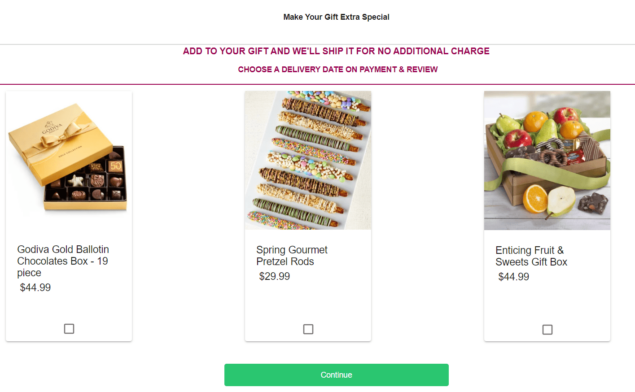
3. Consider cross-selling
Cross-selling is another tactic designed to get customers to add more items to their basket. Usually, cross-selling involves offering a different product or service to a customer with the intent to increase the value of the sale. For instance, a fast-food company asking whether you want “fries with that” is cross-selling. The item offered complements the existing purchase.
You may have noticed examples of cross-selling on sites like Amazon, which tell you which products are typically bought alongside the item you buy. This is a great way for Amazon to encourage people to buy a complete set, or otherwise increase their order value.
One way to cross-sell is to include suggested products on your website. For example, if you sell skincare products, it would be beneficial for customers to purchase multiple items, like a cleansing balm, sunscreen, and moisturizer. On the page listing for the cleansing balm, you could add the sunscreen and moisturizer as suggested products at the bottom of the page. If you sell a bundle that includes all of these pieces, you could even show that bundle as a suggestion. For example, if you go to Primally Pure’s “Clarifying Face Mask” product page, here are the suggested products at the bottom of the page:
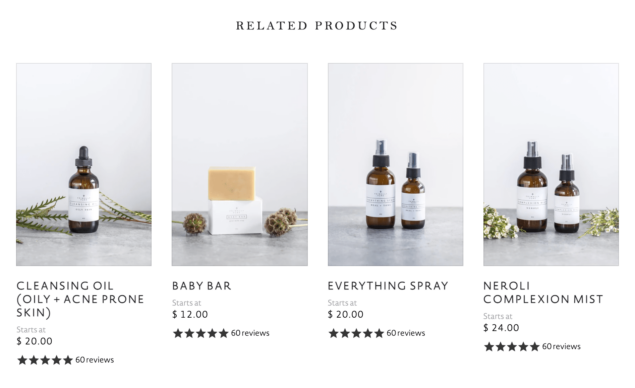
To be successful in cross-selling, the products you offer need to be relevant, and available for a good price. Make your customers feel like they’re getting a deal.
4. Include social proof
One of the most common reasons to leave a basket or abandon a purchase is lack of trust. If your company is still relatively new, then customers might be concerned about the quality of your products, or whether you’re worth spending money on.
Social proof helps to eliminate this concern. Social proof can include testimonials on your website, but those typically aren’t as effective as other forms of social proof. The best kind is organic social proof, where your customers post about and share their love of your brand, product, or service on their social media.
This shows wary customers that someone else likes your products and that they like them enough to actually share about it on their own page. People are more likely to trust real people than brands, so when you see someone posting about your brand, consider messaging them and asking if you could re-post their comments on your own social media.
There are a couple of ways you can do this. First of all, you can use social proof as user-generated content that you reshare on your social media. Or, you can also share any reviews or posts your product may get on your website. Again, this might not be quite as effective, since you could theoretically edit it before it went up on your site. The bottom line is that your customers want to trust you before they make a purchase, and social proof helps them do that.
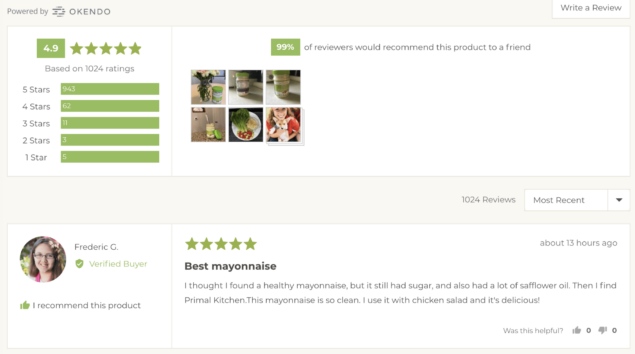
You can also use a review platform to allow your customers to leave reviews right on your website. This is an example from Primal Kitchen’s Mayo Made With Avocado Oil product page, and this particular product has over 1,000 ratings. When you’re just getting started you won’t have that many, but even one or two can be helpful.
Around 84% of people trust online reviews, making social proof a massive part of any e-commerce marketing strategy. Tools like Okendo allow you to collect reviews from customers, show recent sales activity and even offer awesome analytics for you to track increases in sales.
5. Use a countdown sales timer
A countdown sales timer is a widget you can add to your website to encourage sales.
Often, when customers aren’t sure about a purchase, they spend more time lingering on a page. These moments of uncertainty can cost you some serious sales. A good strategy for e-commerce marketing is to push your client into the purchase, by convincing them they’re going to miss out on something great.
A countdown timer gives your client or customer a certain amount of time to purchase a product or take advantage of a great deal. This strategy entices the shopper to buy now and avoid feeling regret later. It’s the classic “Fear of Missing Out”.
You might have seen timers like this on websites before, and Shopify has its own extension to add one to your shop. This example comes from the Shopify example store.

6. Offer personalized suggestions
Cookies are a wonderful thing – and not just in the food world.
With website cookies and memberships, you can gather valuable information about your audience, so that you can tailor your e-commerce marketing campaigns to suit them.
For instance, if someone who has an account with your website comes back to check out more of your products, you could suggest items they might want to see based on previous purchases. With cookies on a customer’s browser, you can even show them items they recently viewed, and they don’t have to be logged into anything.
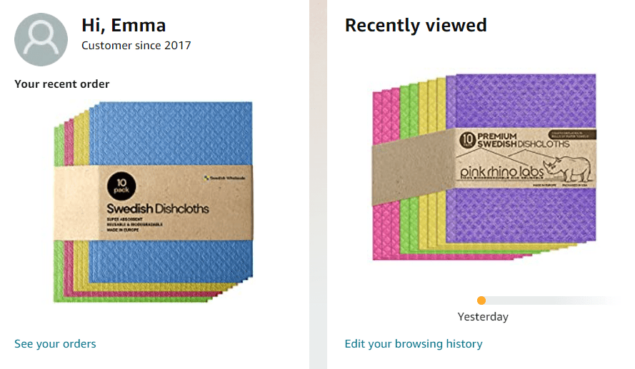
Amazon uses this strategy to increase its customer’s chances of remembering which products they want to add to their basket.
Social media marketing
7. Sell on Instagram
Your Shopify store might be the heart of your e-commerce strategy, but it doesn’t have to be your only avenue for sales. If you have a highly visual business, like a company selling makeup or art supplies, then you could achieve some fantastic engagement levels by selling through Instagram.
One of the best things about Instagram is that many of your customers will already be on there, looking for products and services. The majority of Instagram users follow at least one brand, so when you create an Instagram account, you’ll want to begin building your following. When you have a large number of Instagram followers, you’ll create brand recognition on the platform. You can more easily reach potential customers and help educate them on your brand and your product, leading to better conversions down the road. Instagram is a great marketing platform, but it can also be a sales platform, too.
Instagram also allows you to create shoppable posts, where customers can buy your products on the Instagram app. You can even send people directly to sales pages on your website with the “swipe up feature” as Escape Campervans does here:

Making the most of Instagram for sales is a great way to reach your customers on multiple platforms. Meeting your customers where they already are should boost your conversions.
8. Run social media contests
Don’t limit yourself to swipeable Instagram posts.
There are around 4.41 billion social media users in the world today. If you know where your customers are spending their spare time, take advantage.
One of the best ways to engage your audience, and update your e-commerce marketing, is with social media contests. Competitions and contents have a range of benefits. First, they engage your audience, getting them excited about the chance to win something.
Contests also allow you to encourage lots of user-generated content that you can share later. You can even encourage people to @tag a friend for a chance to win, which improves your brand reach. @Equatorcoffees on Instagram created a giveaway with four other brands to grow their followings and engagement.
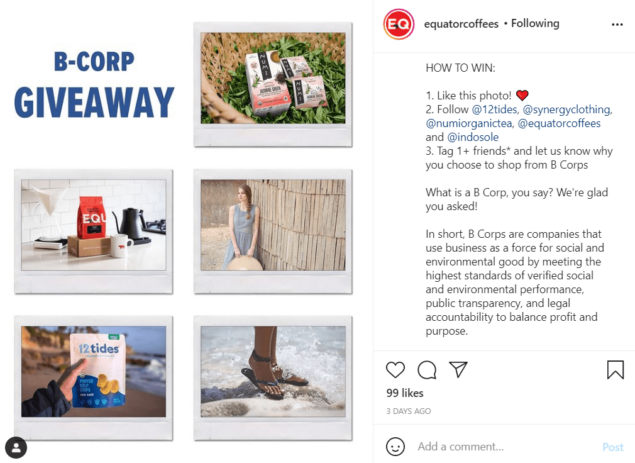
9. Capitalize on Facebook shops
We’ve mentioned selling on Instagram and marketing on social media above. Another great way to upgrade your e-commerce marketing is to create a store on the world’s biggest social platform, Facebook. Facebook shops are an excellent way to attract more attention to your brand.
According to experts, shoppers in the US spent more than $19.42 billion purchasing items through their social networks in 2019. Facebook shops give you an extra storefront where you can sell your items, without asking your customer to leave their favorite social platform.
Facebook shops are somewhat new to the social media selling game, but they’re incredibly popular. If your brand has a business Facebook account (which it should), you can create a free Facebook shop. Once your shop is established, you can customize it to promote certain products and layout the storefront in a way that fits with your branding. You can also use these shops to create Facebook or Instagram ads to better drive traffic to the shop.
Shoppers can find your shop through the ads or directly from your Facebook page or Instagram profile, like The Tiny Tassel in this example. Facebook shops even give shoppers the ability to chat with someone from your store using Facebook Messenger, Whatsapp, or direct messages on Instagram.
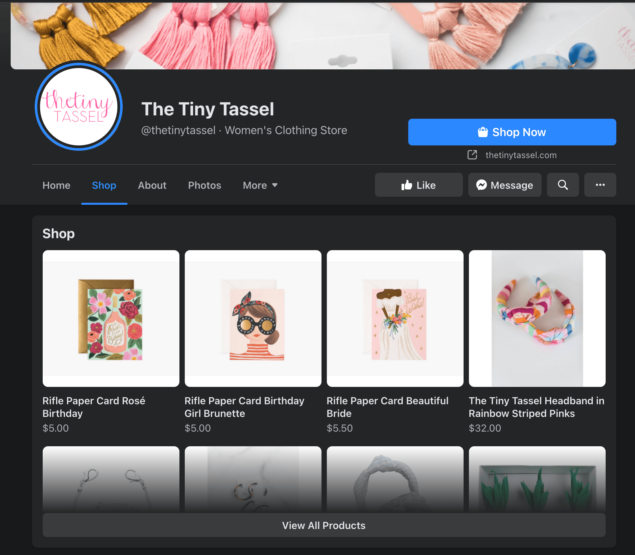
Facebook shops are ideal for those customers in your community who want the easiest possible route to purchase. With these pages, you don’t need to worry about getting a customer to click through to your page. They can buy whatever they like then and there.
PPC marketing
10. Try paid ads
Paid advertising is still one of the best ways to drive more attention to your online store. With tools like Google AdWords and Google Merchant, you can pay for the opportunity to appear higher on the search engine result pages for your chosen keywords.
Paid ads are a great way to boost your presence online and gain a lot more attention from customers in search of the right solutions to their problems. Google has some great tutorials that can walk you through step-by-step how to create and publish your first ad campaign.
Once you’re set up, you’ll need to set aside some time to analyze your results, make changes and evaluate. For example, you might try raising your bids, adding new keywords, or even changing your ad copy. The most important thing to remember is that you only want to change one thing at a time so you can accurately see what made the biggest impact.
Here you can see that Shane Co. and Kay Jewelers both have paid ads that fire for the search term “jewelry store.” Because that’s a fairly generic search term, chances are they both bid a significant amount to earn that placement.
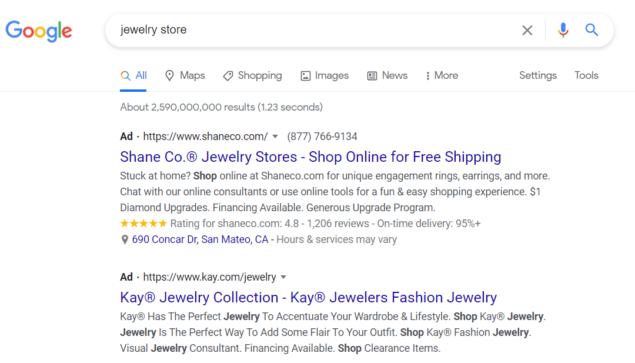
Paid ads often work best when accompanied by strategies for online ranking like organic SEO. The PPC campaigns you pay for will help to initially attract more customers to your website, while your content marketing and SEO campaigns keep those clients coming back for more.
Paid ad campaigns don’t have to stop with Google and other search ads. You can also create successful ad campaigns on platforms like Facebook and Instagram. Learning how to use three different ad platforms can feel daunting, which is why sixads exists. With this simple four-step process, you’ll be promoting your Shopify store on Google, Facebook, and Instagram in no time.
Search engine marketing
11. Rank for the right keywords
As mentioned above, you can use paid advertising strategies to improve your position on the search engines – but it’s not the only way to get results. One excellent option is to invest some time and money into building your SEO strategy.
Say you wanted to sell social media marketing services online, you would write content about kinds of social media marketing, so you can rank higher when people search for things like “Instagram Story Swipe ups” or “Facebook stores”:

You’ll want to do keyword research before you start trying to rank so you make sure you rank for the right keywords. First of all, think about what topics and search terms might actually relate to your product or service. If you’re selling sunscreen, it’s probably not a good idea to try to rank for the keyword “beach ball.” You could, however, try to rank for something like “beach essentials,” since sunscreen could be considered a beach essential.
Once you’ve determined the best keywords to try to rank for, you’ll want to start using them consistently across your website and in your blogs. Each page should focus on a few primary keywords, rather than trying to rank for everything related to your sop.
The great thing about SEO is that you can continue to grow your presence consistently over time. You don’t lose out on visitors just because you stop paying for an ad.
Other marketing strategies
12. Try email campaigns
Sometimes it takes a while to convince your customers to make a purchase.
Most of the people who arrive on your site won’t instantly be ready to purchase. However, they may offer you their email address in an exchange for something valuable.
Collecting email addresses can enhance your e-commerce marketing strategy significantly, giving you a chance to nurture your uncertain leads into customers. When your customers arrive on your site, offer them access to a free download or discount in exchange for their email address, as Kitchenaid does.
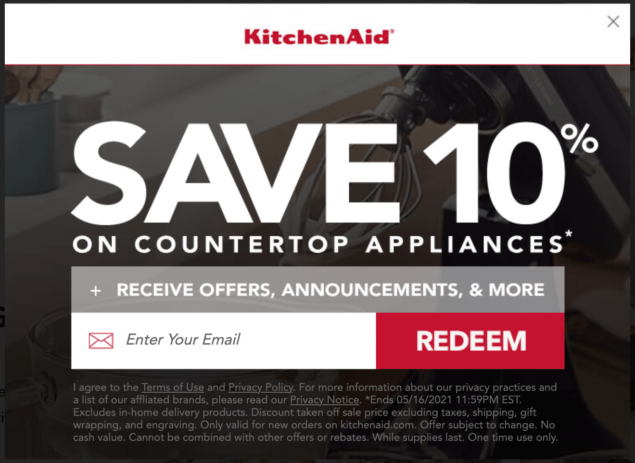
If your client agrees to give you their email, you can then send them messages regularly, designed to encourage them to come back and buy more in the future.
You can even automate your emails and segment your customers to ensure that you’re delivering the most relevant message to each customer. Automated personalized emails have a 75% higher open rate than those without personalization.
13. Implement live chat
Most people see Live Chat applications as tools for support and service. However, you can also access these tools for Ecommerce marketing. According to experts, the number of website visits resulting in sessions through Live Chat has increased significantly in the last few years.
There are various ways that Live Chat tools can improve your conversions. First, it gives your customers a reliable way to ask questions about any products or services they’re uncertain about before they hit the buy button. Sprout Social makes great use of this function.
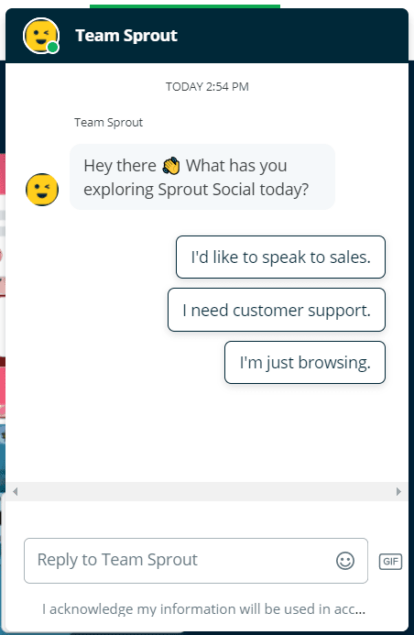
Secondly, you can set up automated chatbots that send customers messages based on the pages they’re on, offering discounts and information that may lead to a sale.
14. Add discount coupons
Who doesn’t love an opportunity to save money?
Although you can’t necessarily give freebies and huge discounts away constantly on your site, you can occasionally use offers to encourage a sale.
A discount coupon can be a great way to push your audience to purchase that they were uncertain about before. You can start with something as small as a 10% voucher code, and still get a fantastic result.

It’s even possible to get more conversions without discounting the purchase at all. According to one study, around 93% of customers buy more items when you include a free shipping option. Allowing your customers to access free shipping if they spend over a certain amount is an excellent way to increase sales.
15. Use gamification
Shopping online can be serious business. However, it’s also a great way to have some fun, if you’re shopping with the right websites. Today’s customers want an amazing experience when they’re buying products on the web. Gamifying your website can be an excellent way to boost engagement and get customers excited about your store.
One option for gamification is to give your customers the option to win points or rewards every time they buy something from your company. Starbucks offers an amazing example of this with their membership and loyalty cards:
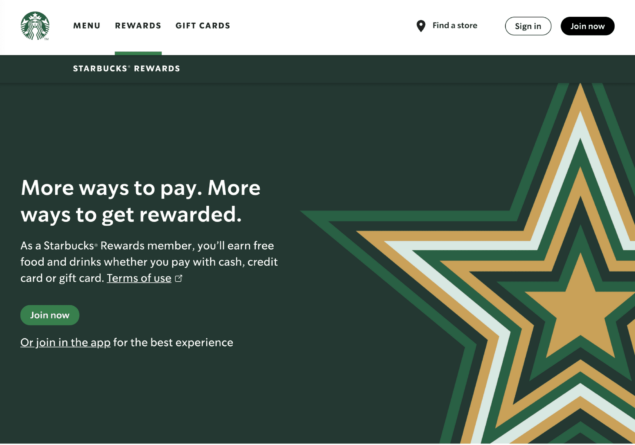
You can also add real gamification to your site in the form of wheels that customers can spin to get a discount. Ask customers to enter their email addresses for a chance to spin, and you build your email list too!
Now, start marketing
The “if you build it, they will come” approach doesn’t work for e-commerce stores. Fortunately, there are plenty of ways to elevate your e-commerce marketing and drive more traffic to your product pages, and some will work better for certain kinds of shops than others.
For a niche e-commerce store, you might want to begin focusing on ranking for the right keywords, paid ads, and social media marketing tactics. This is one of the best ways to find your ideal target audience and work to appeal to them.
A small boutique could benefit from email campaigns, a countdown timer, and social proof. Even if you don’t have a lot of reviews, showing a few happy customers can be a great way to reassure your audience.
A big e-commerce store with many products could offer discount coupons, gamification options, live chat, and personalized suggestions. They likely have a bit more budget to work with, so any PPC marketing could work well for them, too.
For a store with a very small budget, work on your search engine marketing, email campaigns, organic social media, and website marketing options. Since you’re in control of your website, you can add upsell and cross-sell options, as well as work on an abandoned cart sequence.
No matter what your shop’s situation is, there’s always a new way to market your products to get them in front of your ideal customers. Try a handful of the options above, and don’t forget to track your results, so you can see what works best.




